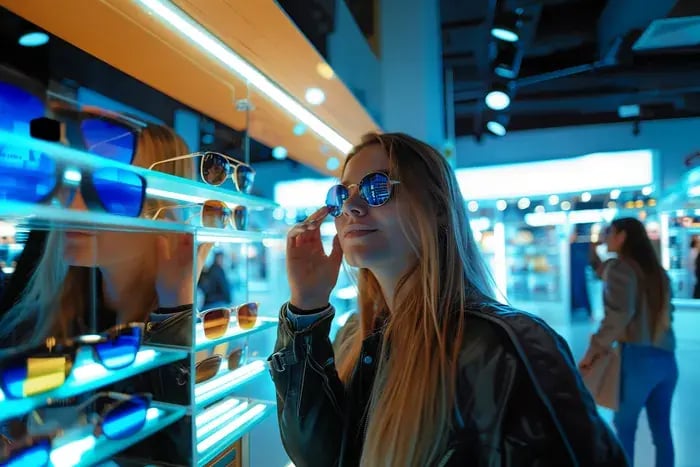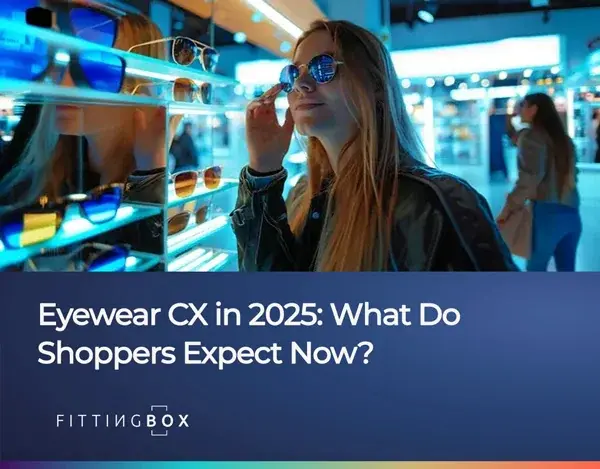.webp)
Eyewear CX in 2025: What Do Shoppers Expect Now?
In 2025, the eyewear industry is experiencing a major transformation in how shoppers engage with brands. Customer expectations are shaped by instant access to information, seamless digital tools, and personalized services. From virtual try-ons to AI-powered recommendations, technology is redefining every step of the buying journey.
For optical retailers, delivering an exceptional experience is no longer optional, it is the foundation of loyalty and growth. Understanding the evolving customer experience in 2025 helps you anticipate needs, enhance satisfaction, and remain competitive in an increasingly demanding market.

🔑 Key Takeaways
-
Eyewear shopping in 2025 blends online and in‑store experiences for a smooth, connected customer journey.
-
Virtual try‑on technology and 3D visualization have become essential for boosting shopper confidence in purchases.
-
Personalized frame suggestions driven by AI and face shape recognition increase conversion rates by over 25%.
-
Sustainability in eyewear choices builds customer trust, influencing brand loyalty and long‑term engagement.
-
Well‑trained sales teams equipped with digital tools elevate the overall eyewear shopping experience in 2025.
How Eyewear Customer Experience Has Evolved by 2025
Over the past few years, the eyewear customer journey has shifted dramatically. Between 2023 and 2025, shoppers have moved from viewing glasses as a purely functional product to treating them as a personalized fashion and lifestyle choice. This shift has reshaped expectations across every touchpoint.
The integration of online and in-store experiences has been a key factor. Customers now expect to browse, compare, and try on frames virtually before visiting a store, or even complete the purchase entirely online. This omnichannel approach has set a new standard for convenience and speed.
Personalization has become equally critical. Shoppers are drawn to eyewear retailers that use their preferences, facial features, and style history to offer curated frame suggestions. By 2025, customer experience success depends on making the process effortless, engaging, and uniquely tailored to each individual.
Key Trends Shaping the Eyewear Customer Journey
In 2025, several trends are redefining how customers interact with eyewear brands. The most noticeable shift is the demand for seamless virtual engagement. Shoppers expect to try on frames digitally, access instant product information, and receive personalized recommendations without friction. This experience is no longer a premium feature but a standard expectation.
Data-driven personalization is another major influence. Artificial intelligence now enables retailers to analyze preferences, purchase history, and even face shape to recommend ideal frames. According to a 2024 report, personalized recommendations increase conversion rates in eyewear retail by more than 25%.
Sustainability also plays a role. More customers are considering eco-friendly materials, repair programs, and transparent sourcing as part of their buying decisions. Offering clear sustainability commitments directly influences brand trust and loyalty.
Technology as a Driver of Satisfaction
Technology tools are at the core of the eyewear experience in 2025. Virtual Try-On allows shoppers to see how frames look instantly, while the 3D Viewer provides a realistic and detailed visualization of materials and design. Lens Simulator tools help customers understand lens thickness, coatings, and effects before purchase. Retailers integrating these solutions report significant boosts in engagement and purchase confidence.
Meeting Customer Expectations in Eyewear Retail
In 2025, meeting shopper expectations in eyewear retail requires an integrated approach. Customers want a smooth journey whether they shop online, in-store, or combine both. A fragmented experience can lead to frustration and brand disengagement. Retailers must ensure consistency in pricing, availability, and frame selection across all channels.
Precision tools have become essential to building customer trust. Pupillary distance measurement, for example, helps guarantee accuracy in lens fitting, reducing the risk of returns. Face shape recognition technology further enhances the selection process by suggesting frames that fit individual features. These tools are no longer optional add-ons; they are expected parts of a modern eyewear experience.
Retailers who combine high-quality product offerings with advanced digital experiences can stand out in a competitive market. The key is to provide services that are not only innovative but also intuitive for customers to use.
Preparing Your Business for the 2025 Eyewear Experience
Adapting to the 2025 eyewear customer experience means anticipating future demands while staying grounded in current best practices. Retailers who invest in innovation now are better positioned to respond to evolving shopper behaviors. This includes upgrading both digital platforms and in-store experiences.
Immersive tools are becoming standard. Virtual fitting, 3D frame visualization, and interactive lens simulations help shoppers feel confident in their purchase decisions. Integrating these solutions creates a consistent and engaging buying process across all touchpoints.
Staff training is another critical component. As technology becomes more sophisticated, sales teams must be equipped to guide customers effectively through these experiences. Whether explaining the benefits of specific lens options or assisting with a virtual try-on, knowledgeable staff enhance the overall customer journey.
Conclusion
The eyewear customer experience in 2025 is defined by personalization, convenience, and technology-driven engagement. Shoppers expect seamless interactions across online and in-store channels, supported by tools that make frame selection and lens customization effortless. For retailers, this is both a challenge and an opportunity.
By investing in immersive digital solutions, maintaining consistency across platforms, and training teams to deliver expert guidance, optical businesses can exceed shopper expectations and build lasting loyalty. Staying ahead of these evolving demands ensures a stronger position in a competitive and rapidly changing market.
LET'S TALK
Request a demo, a quote or set up an appointment with one of our sales representatives.
CONTACT USUseful Links
Corporate
© FITTINGBOX 2025 • Terms of use • Privacy & Legal



